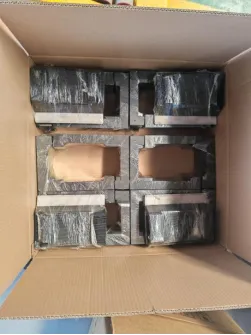Types of Chip Conveyors for Efficient Material Handling in Manufacturing
Understanding Chip Conveyor Types A Comprehensive Guide
Chip conveyors are essential components in manufacturing and machining processes, particularly within industries that utilize CNC (Computer Numerical Control) machines. They play a crucial role in efficiently transporting metal chips, shavings, and other scrap materials away from machines, ensuring a cleaner working environment and enhancing overall productivity. This article delves into the various types of chip conveyors, their functionalities, and the advantages they offer in industrial applications.
1. Types of Chip Conveyors
There are several types of chip conveyors, each designed to cater to specific needs and operational conditions. The most common types include
- Auger Conveyors Also known as screw conveyors, auger conveyors use a helical screw to move materials along a casing. This type is particularly effective for transporting metal chips and other small debris. They can handle wet chips and are often used in machining environments where liquid coolant is present.
- Drag Chain Conveyors These conveyors feature a series of chains or links that drag the material along a trough. They are ideal for heavier and bulkier materials, making them suitable for environments with high volumes of scrap. Drag chain conveyors are robust and can handle various shapes and sizes of chip material.
- Magnetic Conveyors Utilizing magnetic forces, these conveyors are designed to transport ferrous materials. Magnetic conveyors are especially advantageous in operations where separation of ferrous chips from non-ferrous materials is necessary. They provide a reliable and efficient method for handling metal scrap without letting smaller pieces escape.
- Belt Conveyors These are one of the most traditional forms of conveying systems. They utilize a belt to transport materials from one point to another. Belt conveyors are versatile and can be used for a wide range of materials, making them suitable for different types of chip removal applications.
- Vacuum Conveyors These systems use suction to move materials through a piping system. They are typically used in applications requiring a clean and less noisy operation. Vacuum conveyors are excellent for small, lightweight chips and can effectively separate chips from coolant.
2. Applications of Chip Conveyors
Chip conveyors are widely used across various sectors, including
- Metalworking In machine shops, chip conveyors integrate seamlessly with CNC machines, lathes, and milling machines to remove chips and shavings efficiently
.chip conveyor types

- Automotive Manufacturing The automotive industry produces significant amounts of metal scrap during machining operations. Chip conveyors help maintain cleanliness and streamline production processes.
- Aerospace Manufacturing Precision machining in aerospace often generates chips that need to be managed efficiently, making chip conveyors indispensable in these advanced manufacturing environments.
- Woodworking While primarily associated with metalworking, chip conveyors are also utilized in woodworking to handle wood shavings and dust, ensuring machinery operates effectively.
3. Advantages of Using Chip Conveyors
The integration of chip conveyors in manufacturing processes offers several key advantages
- Increased Efficiency By automating the chip removal process, manufacturers can minimize downtime, allowing machines to operate continuously without interruptions for manual cleaning.
- Improved Safety The reduction of scrap materials on the shop floor helps create a safer working environment, minimizing the risk of slips, falls, and other accidents.
- Enhanced Product Quality Effective chip removal prevents chips from re-entering the machining process, reducing the likelihood of contaminating finished products and improving overall quality.
- Cleaner Workplace By continuously removing scrap materials, chip conveyors contribute to a cleaner and more organized work environment, which can enhance employee morale and productivity.
Conclusion
Chip conveyors are an indispensable part of modern manufacturing processes, offering a range of solutions tailored to various materials and operational requirements. Understanding the types of chip conveyors available and their applications can significantly influence a manufacturer’s efficiency, safety, and product quality. As technologies evolve, the design and functionality of chip conveyors will continue to advance, further enhancing their role in the manufacturing landscape.








